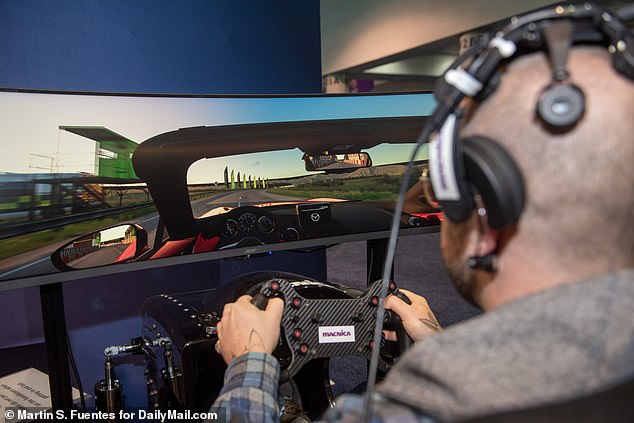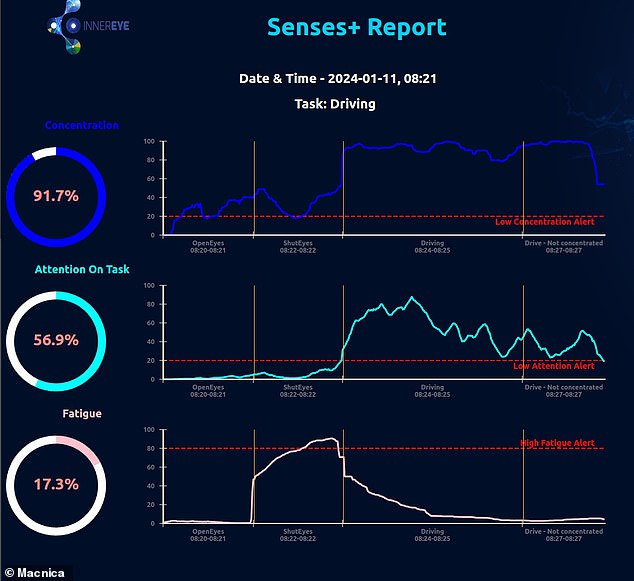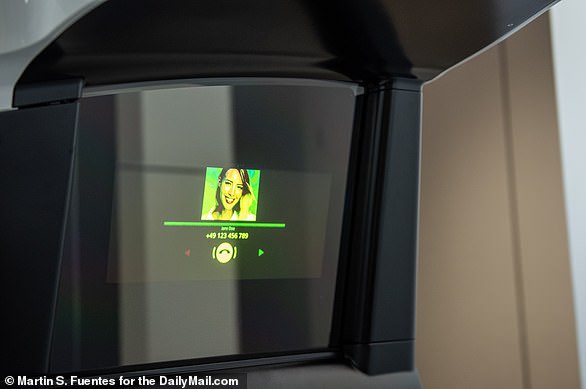We tried out this dystopian helmet that monitors your BRAIN WAVES while you drive – and barks at you if you’re not paying attention!
A new helmet that monitors your brain while you ride aims to prevent accidents caused by fatigue or loss of concentration.
The dystopian invention is from Japanese company Macnica – and DailyMail.com tried it out at the CES technology conference in Las Vegas this week.
The helmet uses a series of electrodes and sensors that monitor activity in key parts of your brain.
“By measuring your brain activity, we can measure your state millisecond by millisecond, from simple measurements like how sleepy you are to more advanced concentration,” Leon Deouell, Inner Eye’s chief science officer, told DailyMail.com.
Before the driving simulation started, Macnica employees calibrated the EEG device to properly read my brain waves
By tapping into your brain waves and analyzing them with AI, Macnica generates a readout that shows how well you concentrate, whether you are distracted and how sleepy you are.
At this time it is purely for research purposes, not for customers to use in their cars.
One of the main goals of this technology is to help engineers design the vehicles of the future.
Using driver attention data, they can see the results of their design and engineering efforts in black and white, adjusting systems to keep the driver engaged behind the wheel.
If it senses you’re distracted or sleepy, it will trigger built-in notifications to alert you to tune back in or take a break.
They will also be able to make autonomous vehicles safer and more enjoyable to drive, Deouell said.
Of course, you may find yourself focusing on your conversation with the passenger next to you, rather than on the road.
So they separate these two types of attention, focusing on one called “attention on task.”
Deouell’s company Inner Eye developed the brainwave reading software and worked with Macnica to apply the technology to cars.
If you pay attention and are alert, Deouell said, an autonomous vehicle could take note of your brain state and drive a little faster. But if not, it can cut the flow a bit to make the ride safer.
“The car will interact with your brain,” he said.

I took a quick lap in a driving simulator while the Macnica EEG headset read my brain waves. Needless to say, it showed I was concentrating
I stopped by the company’s exhibit at CES in Las Vegas, where Macnica employees strapped an electroencephalography (EEG) headset to my scalp to see how well I could pay attention behind the wheel of a driving simulator.
First they calibrated the device by having me open and then close my eyes, each for a minute at a time.
Then they dropped me into the driver’s seat and had me drive a virtual Mazda Miata around a race track.
I did well. I went off track and hit a wall once or twice, but once I figured out the paddle shifters I was flying.
All the while, the EEG headset was reading my brain waves.
Then came an unexpected task: dealing with someone else’s road rage.
Driving a simulated Toyota Prius, I slowly merged onto the highway.
A large black SUV soon filled my rearview mirror, flashing its lights to signal the driver wanted to pass.
I laughed nervously, and at that moment I was very focused on avoiding an accident.
But no matter what I did, it wouldn’t just pass and leave me alone.
Soon the truck hit my little hybrid and spun me around, the simulator seat jerking in response.

These graphs mapped my brain activity during calibration (first two sections) and during a defensive driving task (third section). When my eyes were closed during calibration, the computer detected a high level of drowsiness (bottom graph), but when I tried to avoid being rammed off the road, my concentration was high (top graph)
Yusuke Tsukakoshi from Macnica showed me my results on a computer screen.
The readout told the story of my brain state during the driving tasks: high concentration, which became even higher when the SUV started forcing me off the road.
As entertaining as the simulation was, Macnica wants their product to be used by professional engineers in car design.
Several major automotive companies are already working with Macnica, Global Innovation Sourcing Director Masashi Nagamori told DailyMail.com.
Nissan and Toyota are involved, and while you may not get the chance to test Macnica’s EEC limit in a car, you may one day drive a car developed with it.

